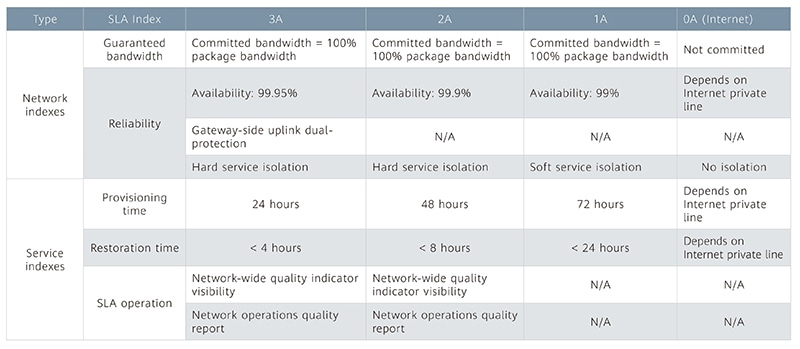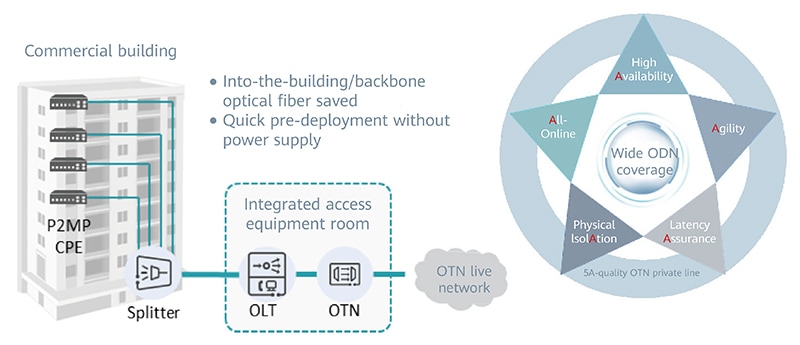New Solutions
How All-optical Intelligent Commercial Buildings Enable SME Digitalization
Premium private lines are the answer carriers need to provide commercial buildings and SMEs with premium services.


By Zhang Han, Solution Architect, All-optical Network Architecture Innovation Lab, Optical Architecture & Technology Planning Dept, Huawei

New infrastructure underpinned by technologies like 5G, F5G, IoT, industrial Internet, big data, cloud computing, and AI is becoming deeply integrated with the real economy in industries such as urban governance, transportation, campuses, enterprise operations, and manufacturing. In turn, this is boosting the economy and promoting the digital transformation of industries.
According to 2021 data from the State Administration for Market Regulation (SAMR), 95% of China’s 42 million enterprises are SMEs. They play a key role in socioeconomic development and serve as the foundation of modern economies. To help SMEs reduce OPEX and become digital, carriers need to provide them with high-quality private-line services.
The White Paper on High-quality Broadband Network Service Experience for SMEs released by the Broadband Development Alliance in 2020 reports that SMEs have specific requirements for private-line quality. These include guaranteed bandwidth, availability protection, hard service isolation, provisioning and recovery time, and SLA visibility (see Table 1). SMEs are also price-sensitive due to OPEX pressures, so they need inclusive OTN private-line services.

Table 1: Private line network and service indicators from the White Paper on High-quality Broadband Network Service Experience for SMEs
Major issues with conventional private line services
SMEs are mostly found in commercial buildings. Their tremendous need for private lines makes commercial buildings a key area of competition for carriers. However, conventional private-line services for commercial buildings face the following issues: 1) A shortage of optical cables in most buildings: Deploying backbone optical fibers in buildings is costly and approval is difficult. 2) Slow delivery: To minimize costs, enterprises need private lines as fast as possible, ideally on the same day as the application or the next day. However, conventional private lines are typically delivered in about 30 days. This creates great pressure on carriers. 3) Homogeneous competition: PON-based delivery is widely used for private lines in buildings, and the backhaul network is based on IP MAN. During peak daytime hours, network congestion often occurs due to heavy traffic, resulting in a poor user experience. Carriers need to focus on user experience to gain differentiated competitive advantages. 4) Low O&M efficiency and a lack of value-added services: The PON+IP transport solution separates service provisioning and O&M into two segments, making fast and integrated service provisioning impossible. As a result, fault location and demarcation are complex and inefficient, value-added intelligent services such as service visibility and adjustable bandwidth cannot be provided, and services are not intelligently scalable.
OTN P2MP private lines enable all-optical digital commercial buildings
In all-optical digital commercial buildings that have deployed the OTN point-to-multipoint (P2MP) solution, SMEs can access premium, premium cloud-access, and Internet private-line services. In the OTN P2MP private-line solution, the OLT and OTN share a site, directly connecting the gigabit access network to the all-optical network. Services are no longer transmitted through the MAN like in conventional PON private lines. This solves problems such as unguaranteed service bandwidth and high delay variation caused by congestion in the MAN during peak hours. The OTN P2MP solution uses point-to-multipoint architecture based on a passive optical splitter at the end of the ODN. This realizes 5A-quality OTN enterprise private lines, while retaining the wide coverage of the ODN, meeting SLA demands of SMEs for bandwidth, stable latency, and quick provisioning, while also providing service quality differentiation.

Figure 1: OTN P2MP solution and its innovations
The OTN P2MP solution delivers the following advantages:
1. Fewer optical fibers required
To ensure service quality for enterprise customers, typical private line solutions use direct optical fiber connections, resulting in great demand for backbone optical cables. The OTN P2MP private line solution requires only one optical fiber to connect to a commercial building and uses 1:16 optical splitting at the end, greatly reducing the use of fibers in the backbone cable. As the OTN P2MP solution reuses existing ODN networks, far fewer optical fibers are required, saving carriers the time and cost of deploying additional cables.
2. Hard pipes
The OTN P2MP solution is the first in the industry to enable an OTN board on the OLT to allow services to be transmitted through OTN-exclusive channels. The OLT isolates regular home broadband services from private line services through network slicing to prevent interference between the two types of services.
3. Low latency
OTN P2MP uses multiple optimization technologies to ensure stable low latency for enterprise private lines.
(i) Dual-wavelength isolation for reducing delay variation
The dual-wavelength isolation mechanism separates the wave channels for services and administration. The service wave channel transmits data and the administration wave channel manages signals. This enables the independent detection of CPEs that go live, preventing delay variations caused by the ONT that detects terminal access and reducing the uplink delay variation in the access segment to less than 150 μs.
(ii) Fixed timeslot allocation for lowering latency
The fixed timeslot allocation mechanism fixes the timeslots used by each enterprise CPE for transmission and these are automatically allocated by the OLT in advance. The OLT and the CPE do not need repeated handshakes to dynamically apply for timeslots, so the highest transmission latency in between can be limited to about 200 μs.
4. Intelligent management and control
The OTN P2MP solution fully upgrades the way networks are managed and controlled and provides a northbound interface for connecting with carriers' BSSs/OSSs to deliver intelligent service capabilities.
In conventional private line solutions, PONs and OTNs are separately managed, so end-to-end management is not possible and the performance metric data of private lines cannot be centrally viewed.
With the OTN P2MP solution, users can directly access the iMaster NCE-FAN by installing cross-domain components in iMaster NCE-T, realizing the centralized management and control of PONs and OTNs through smooth upgrades. The iMaster NCE intelligent management and control system supports the cross-domain management and control of transport OTN and access PON devices. It also delivers functions such as quick provisioning, SLA visibility, and the self-service bandwidth adjustment of OTN P2MP private line services. The resulting self-service experience is similar to online shopping, and includes temporary network acceleration for livestream events, checking private line quality, and adjusting speeds.
5. Diversified protection
The OTN P2MP solution provides a range of protection mechanisms such as Type B, SNCP, and OTN ASON, realizing 99.99% reliability.
OTN P2MP: The best inclusive premium private line solution for carriers
On July 7, 2021, China Unicom Guangdong and Huawei jointly launched the world's first OTN P2MP premium private-line service in the Shenzhen-Dongguan metropolitan area. The service will bring high-quality connectivity to industries and help boost the digital economy in the Guangdong–Hong Kong–Macau Greater Bay Area. China Unicom Jiangsu also launched the OTN P2MP premium private-line service in Suzhou in the same month.
On September 10, 2021, China Mobile Guangdong and Huawei jointly launched the first OTN P2MP cloud-access private line in China. This service facilitates the digital and cloud transformation of SMEs in China, and enriches China Mobile's enterprise private line portfolio.
In September 2021, China Telecom Shandong and Huawei jointly launched China Telecom's first premium private line, providing cloud-based video backhaul private-line services for Shandong Land Development Group. In October 2021, China Telecom Sichuan also launched the OTN P2MP private-line service. Verified performance metrics, such as latency and jitter, demonstrate the solution's ability to meet the premium experience needs of enterprise customers.
As the digital economy thrives, equipment providers like Huawei are committed to strengthening their technical solutions to support information-based transformation and bring convenience, a premium experience, and high-quality services to SMEs.
- Tags:
- Optical Networks






